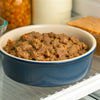Do Dogs Need Wet Food and Dry Food? A Deep Dive into the Best Feeding Practices
- Houndsy
Table of Contents
- Introduction
- Understanding Wet and Dry Dog Food
- The Nutritional Battle: Wet vs. Dry
- Merging the Best of Both Worlds: Mixing Wet and Dry Dog Food
- Special Considerations When Choosing Dog Food
- Conclusion
Introduction
Did you know that nearly 80% of dog owners struggle with deciding the right diet for their furry friends? Navigating the extensive array of dog food options can feel like a daunting task, especially when it comes to choosing between wet food and dry food. As pet parents, we want to ensure our dogs are getting the nutrition they need to thrive while also considering their taste preferences. The purpose of this blog post is to demystify the age-old debate: do dogs need wet food and dry food?
In this comprehensive guide, we'll explore the pros and cons of both wet and dry dog food, examine the nutritional benefits of each, and discuss the factors that can influence your choice. We’ll also delve into mixing feeding options, which many pet owners find appealing. By the end of this article, you'll be equipped with the information you need to make the best dietary choices for your beloved canine companion.
So, let’s embark on this journey to understand how we can enhance our dogs’ feeding experiences and ensure their health and happiness.
Understanding Wet and Dry Dog Food
What is Wet Dog Food?
Wet dog food, often referred to as canned or soft food, consists primarily of meat and is typically blended with water, broth, or gravy to create a moist texture. It contains approximately 75-85% moisture, making it significantly more hydrating than dry kibble. Common forms include chunks in gravy, pâtés, and stews.
What is Dry Dog Food?
Dry dog food, usually known as kibble, is composed of meat and other ingredients blended into a dough, shaped into small, bite-sized pieces, and cooked. It generally contains around 10% moisture, allowing it to have a longer shelf life and making it easier to store than wet food. Kibble comes in various shapes and sizes to cater to different dog breeds and sizes.
The Nutritional Battle: Wet vs. Dry
Nutritional Considerations
Both wet and dry dog foods can provide a balanced diet for our furry friends, but they differ in several key areas:
-
Moisture Content
- Wet Food: High moisture levels can benefit dogs that may not hydrate adequately or have specific health issues, such as urinary problems.
- Dry Food: Lower moisture can be fine for healthy dogs, but it may require careful monitoring of water intake.
-
Caloric Density
- Wet Food: Generally contains fewer calories per cup due to its high water content, which can aid weight management when used appropriately.
- Dry Food: Higher caloric density can be beneficial for active dogs or those needing to gain weight, but it can also contribute to obesity if overfed.
-
Palatability
- Wet Food: More enticing for picky eaters due to its aroma and texture, which may make it easier to coax sick or elderly dogs to eat.
- Dry Food: While not as aromatic, it offers a crunch that some dogs may prefer. It can be challenging to entice picky eaters accustomed to wet food to switch to dry food.
Key Benefits of Wet Dog Food
Wet dog food offers several advantages for pet owners:
- Hydration: Ideal for dogs that do not drink enough water, helping to support kidney and urinary health.
- Flavor and Texture: More appealing to many dogs, making it easier to entice picky eaters.
- Easier Chewing: Suitable for older dogs or those with dental issues as it requires less effort to chew.
Key Benefits of Dry Dog Food
Dry food also brings many benefits to the table:
- Convenience: Easier to measure and serve, with a long shelf life that allows for bulk buying and minimal preparation.
- Dental Health: The crunchiness can help reduce plaque build-up on dogs' teeth, promoting better oral hygiene.
- Calorie Control: Helps regulate calorie intake for dogs that need to maintain or lose weight effectively.
Merging the Best of Both Worlds: Mixing Wet and Dry Dog Food
While we may be inclined to favor one type of dog food, mixing wet and dry options can be a compelling compromise that combines the benefits of both. Here are a few reasons why mixing may be advantageous:
- Variety: Dogs can enjoy different flavors and textures, which can help overcome fussy eating habits and stimulate their appetite.
- Cost-Effectiveness: Mixing can lower overall food costs while still allowing your dog to experience the palatability of wet food.
- Balanced Nutrition: It’s possible to balance out caloric intake by mixing, allowing for better adherence to dietary needs without sacrificing taste.
How to Mix Wet and Dry Dog Food Safely
To effectively mix wet and dry food, we recommend the following steps:
- Consult a Veterinarian: Ensure the overall diet meets your dog's caloric requirements and nutritional needs.
- Measure Portions Carefully: Keep an eye on total caloric intake from both food types, adjusting portions as necessary.
- Transition Gradually: Introduce new foods slowly to avoid digestive upset, allowing your dog to adjust over several days.
Special Considerations When Choosing Dog Food
As loving pet owners, we need to consider our dog's individual needs when deciding between wet and dry food. Some common factors include:
- Age and Size: Puppies and senior dogs may benefit more from wet food due to its texture, while active adult dogs may thrive on dry food.
- Health Conditions: Dogs with specific ailments, such as dental disease, diabetes, or digestive issues, may require tailored diets that lean towards one type of food.
- Preferences: Ultimately, every dog is unique. Keep in mind their likes and dislikes to ensure mealtime is a pleasurable experience.
Frequently Asked Questions
1. Do Dogs Need Wet Food and Dry Food?
No, dogs do not strictly need both wet and dry food. However, offering a combination can provide variety and meet the nutritional needs of dogs with different preferences or dietary restrictions.
2. Which Type of Food is Better for My Dog?
The best food depends on your dog’s individual needs, preferences, and health considerations. Consult your veterinarian for recommendations tailored to your dog’s specific requirements.
3. Can I Mix Wet and Dry Dog Food?
Yes! Mixing wet and dry dog food is a common practice that can enhance palatability and ensure your dog receives balanced nutrition. Just be mindful of the total caloric intake to prevent overfeeding.
4. Will Wet Food Cause Dental Issues?
While wet food alone does not inherently cause dental problems, it is essential to incorporate dental care practices to ensure your dog's oral health. Regular check-ups, dental treats, and chews can help maintain dental hygiene.
5. Is it OK for Puppies to Eat Wet Food?
Absolutely! Wet food can be an excellent choice for puppies, especially during their weaning phase, as it is easier for them to chew and can aid in their transition to solid food.
Conclusion
As dog owners, we play a vital role in ensuring our furry companions enjoy balanced diets delicately tailored to their needs. Whether we choose wet food, dry food, or a combination of the two, the ultimate goal remains the same: keeping our beloved pets happy and healthy.
Remember, when considering how to elevate your dog's feeding experience, our Houndsy Kibble Dispenser can simplify meal prep, providing perfect portions and eliminating the mess often associated with feeding. Let’s enhance our pet care routine with innovative solutions like the Houndsy Kibble Dispenser, making feeding time an enjoyable ritual for both us and our pups. Explore our Houndsy Kibble Dispenser here.
In conclusion, there’s no one-size-fits-all solution when it comes to feeding our dogs. By evaluating dietary needs, preferences, and health conditions, we can provide our pets with a well-rounded diet, enhance their mealtime experiences, and forge a deeper bond with them through care and consideration.












